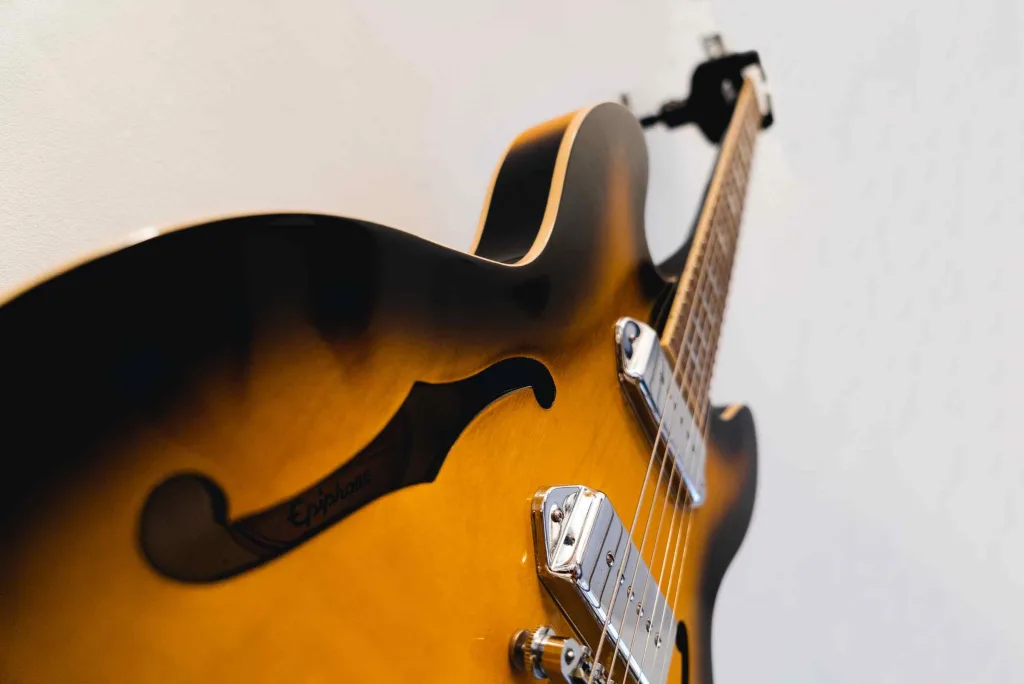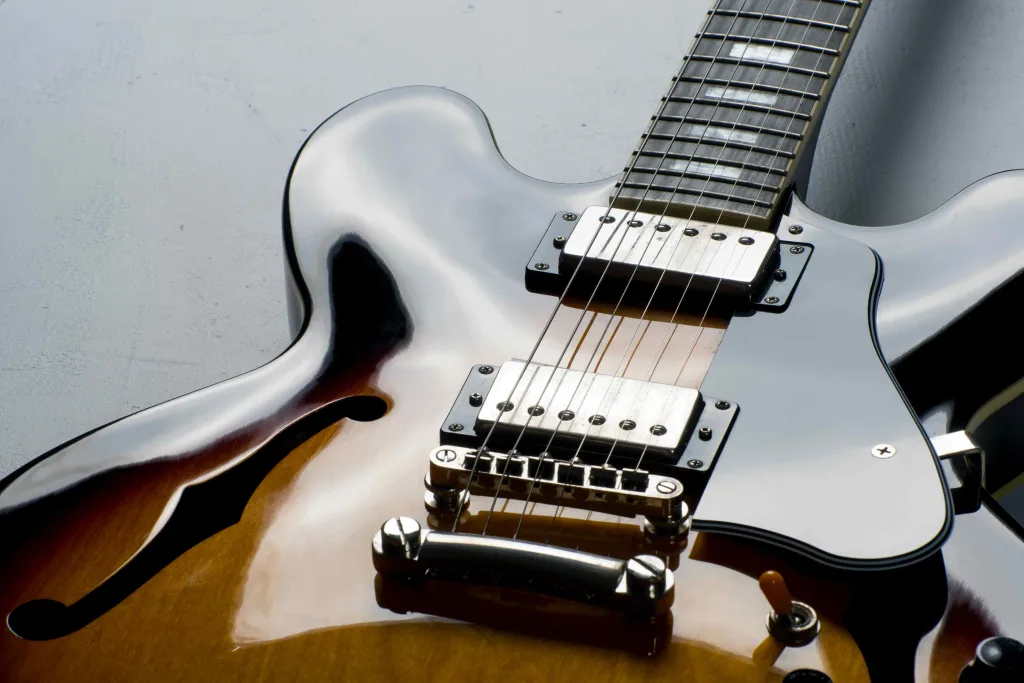When it comes to choosing the perfect guitar, the world of options can be overwhelming. Among the timeless classics, two types of guitars stand out with their enchanting melodies and distinct characteristics – the semi-hollow body and the hollow body guitars.
In this article, we aim to explore the differences between these two captivating instruments. Understanding the unique features and sounds of semi-hollow and hollow body guitars will help you decide which one suits your creativity best.
Let’s explore their qualities and find your perfect match!
A Brief History of Hollow Body Guitar
Back in the late 1920s and early 1930s, people wanted to make electric guitars louder, but it was challenging. Then, George Beauchamp invented special pickups called horse-shoe pickups. With them, he made the first successful electric guitar called the “Frying Pan.”
Gibson also joined the electric guitar race and created the famous ES-150. It also had special pickups and became popular, especially among jazz musicians.
Even though other types of guitars became popular later on, hollow body guitars remained important in music history. Today, many new models are made, but the classic ones like Gibson’s Electric Spanish, Gretsch’s Electromatics, and Epiphone’s Casino are still loved by musicians all over the world.
A Brief History of Semi-Hollow Body Guitar
After Gibson’s ES-150, the first semi hollow body guitar appeared, but it took almost twenty years for it to gain attention. In 1939, Les Paul created a handmade guitar called “The Log” to combat feedback issues during performances and recording sessions. Although Gibson didn’t initially take it seriously, the guitar world changed when Fender introduced solid body electric guitars in 1950.
To compete, Gibson worked on “The Log,” transforming it into the legendary Gibson Les Paul, a rock music icon. But the desire for a semi-hollow electric persisted. Finally, in 1958, Gibson’s Ted McCarty revisited Les Paul’s prototype and created the first successful semi-hollow guitar: the Gibson ES-335.
The ES-335 was unique with its solid center block and thinner body, blending the benefits of solid and hollow bodies. Equipped with humbucking pickups, it offered a new, remarkable tone. The success of the Les Paul and the ES-335 inspired many other brands to produce their own semi-hollow body guitars, making them a favorite among musicians of various genres.

Differences Between Hollow and Semi-Hollow Body Guitars
Differences in Construction
- Hollow Body Guitars: Hollow body guitars have pickups like electric guitars, but their bodies are hollow inside. They often have arched tops and F-holes or similar small soundholes. This design lets the pickups sit on top of the guitar. Hollow bodies usually have adjustable bridges, vibrato tailpieces, and necks that attach at a higher fret.
- Semi-Hollow Body Guitars: Semi-hollow body guitars are a mix of solid and hollow. They have hollow wings and a solid center block where the bridge is placed. This center block reduces feedback and vibrations, giving them a unique tone. Some brands use different center block styles for varied sounds.
Differences in Playability
- Hollow Body Guitars: Hollow body guitars come in many styles, so playability can vary. Early models were big with thick necks, while newer ones had slim necks for faster playing. Today, you can find two types: classic reissues and modern versions. Modern hollow bodies blend vintage charm with modern comfort using fast necks and up-to-date pickups. So, the playability can range from traditional to sleek and speedy.
- Semi-Hollow Body Guitars: Semi-hollow body guitars also offer different playability. Some, like the Gibson ES-335, play like classic hollow bodies with wide fretboards. Others try to be more like solid-body guitars while still having some resonance. Then, there are unique ones that break the mold, like Fender’s Starcaster or Dave Mustaine’s signature Dean. The semi-hollow design became popular, resulting in various versions made by different manufacturers.
Differences in Sound
- Hollow Body Guitars: Hollow body guitars have a focused and slightly brighter tone with prominent mid-range compared to acoustic guitars. They sound warm and earthy but may lack some clarity and sustain in the low end. They might not be as clear as solid body guitars when plugged in and are prone to feedback issues.
- Semi-Hollow Body Guitars: Semi-hollow guitars vary in sound based on pickups, woods, and design. They have less resonance than acoustic-electrics but more than solid bodies. Their tone is sharper and focused, and they can handle higher levels of gain and volume thanks to a feedback-reducing center block. The sound of semi-hollows is diverse, and listening to famous players can help you explore their unique tones.
Differences in Genres
- Hollow Body Guitars: Hollow body guitars are great for genres where overdrive is not needed much. They became popular in jazz, thanks to guitarist Charlie Christian’s performances with original Gibson models. They also found a place in rockabilly, blues, and country music, providing warm and resonant tones for amplified sounds.
- Semi-Hollow Body Guitars: Semi-hollow guitars are versatile and work well in various genres that use electricity. From blues and jazz to swing, soul, rock, and even metal, there’s not much a semi-hollow can’t do. You can get sweet, ringing cleans for soulful leads or crystal-clear chords. They can also handle harder genres with a darker tone. However, at extreme volumes and distortion levels, they might get a bit muddy and prone to feedback, but they can still handle some serious crunch compared to hollow bodies.

Similarities Between Hollow and Semi-Hollow Body Guitars
The hollow body and semi-hollow body guitars have a lot of similarities, which can sometimes confuse beginners.
Here are some of the main similarities:
- Look and Shape: The appearance of these two guitar types is very similar. If you’re looking at an acoustic or semi-acoustic guitar, it’s hard to tell the difference as a beginner.
- Sound Production: While there might be slight differences in resonance and tone, the overall sound production and clarity are quite similar between hollow and semi-hollow body guitars.
Conclusion:
Semi-hollow and hollow body guitars offer a world of musical possibilities. Whether you prefer warm tones or versatile sounds, these iconic instruments are ready for your creative adventure.
Choose your guitar, let the music flow, and enjoy the joy of making music that moves the soul. Happy playing!
FAQ:
Can Semi-Hollow And Hollow Body Guitars Be Played Acoustically?
Yes, semi-hollow and hollow-body guitars can be played without plugging them in, so you can hear their natural sound like an acoustic guitar. But you can also plug them into your favorite amps to create a different, amplified sound. It’s up to you how you want to play and enjoy their versatility!
Do Hollow Body Guitars Have Less Sustain?
Hollow-body guitars have less sustain compared to semi-hollow-body guitars, and semi hollow guitars have less sustain than solid body guitars.
In general, guitars with more high-density wood tend to have more sustain.
Do Hollow Body Guitars Need Amps?
You don’t need an amplifier if you’re playing for yourself or a small audience. But, in a big and noisy room or outdoors, it might be hard to hear them without using an amp.
Can You Play Metal On A Semi-Hollow Or Hollow Body Guitar?
Yes, you can use semi-hollow or hollow body guitars for metal playing, but it’s not the best option. Most metal players prefer solid body guitars like Les Pauls or Super Strats. Semi-hollow and hollowbody guitars can produce uncontrolled feedback when playing with high gain and distortion, which can be a big problem.
To control the feedback, some players stuff rags inside the guitar, like Billy Duffy. However, this changes the guitar’s sound. Nowadays, the best way to control feedback is by using a noise gate pedal, which works on any type of guitar.

